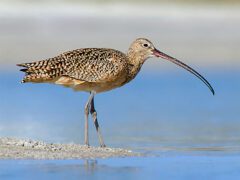Gray Heron Similar Species Comparison
Main SpeciesGray Heron
Adult
A large, gray heron with a heavy, daggerlike bill. Adult has a broad black stripe above and behind each eye, a white central crown stripe and white face, black shoulder patches, dark gray upperparts (with lighter gray plumes in breeding season), and a grayish-white neck with black streaks down the middle. The bill is orange in full breeding plumage.
© Patrick MONNEY / Macaulay LibraryFreiburg, May 11, 2018Juvenile
Juvenile is duller overall, with a muted head pattern that lacks the crisp black-and-white stripes of an adult. The neck is the same light gray as the back and wings. Juvenile lacks plumes and has duller bill and legs than adult.
© Christoph Moning / Macaulay LibrarySchleswig-Holstein, August 22, 2010Adult
A large, long-necked heron found in lakes, ponds, and other wetlands. Adult in breeding plumage has gray upperparts (with lighter gray plumes), a grayish-white neck with black streaks down the front, a white face and crown stripe, a broad black stripe above and behind each eye, and a long black plume extending from the back of the head.
© Josep del Hoyo / Macaulay LibraryCsongrád, May 02, 2015Adult
Gray Herons fly with the neck tucked in, creating a bulge below the back of the head. In flight, note the two-toned upperwing pattern: black flight feathers and gray inner coverts, with a small white patch at the bend of the wing.
© Chris Maines / Macaulay LibraryTokyo, December 01, 2017Adult
Underwings appear more uniformly dark gray. During peak breeding season, both the bill and legs can become bright orange-red.
© Neoh Hor Kee / Macaulay LibrarySelangor, April 26, 2016Immature
Immature is duller overall and lacks the crisp white-and-black facial patterning of an adult. This heron eats mostly fish, which it catches by standing motionless—or in this case, walking slowly in shallow water—before quickly striking.
© Josep del Hoyo / Macaulay LibraryEngland, August 16, 2017Adult (Mauritanian)
The rare “Mauritanian” Gray Heron is much paler than the common, widespread “Gray” Gray Heron.
© Andrew Spencer / Macaulay LibrarySaint-Louis, December 29, 2018Adult (Madagascar)
The “Madagascar” Gray Heron is typically larger than “Gray” Gray Heron, with a larger bill and longer legs.
© Holger Teichmann / Macaulay LibraryToliara, August 07, 2018Adult
Performs treetop courtship displays that include elaborate stretches, erected plumes, calls, and bill snaps.
© Josep del Hoyo / Macaulay LibraryRajasthan, July 02, 2014Adult
Forages in a wide variety of shallow wetlands, including lake shores, marshes, ricefields, and fishponds.
© Sneha Gupta / Macaulay LibraryMaharashtra, September 27, 2016Adult
Female builds stick nest from materials delivered by male. Nests are high up in treetops and often reused from year to year.
© Josep del Hoyo / Macaulay LibraryProvence-Alpes-Côte d'Azur, April 17, 2017Similar SpeciesPurple Heron
Adult
Adult Purple Heron is darker overall, with a rusty tinge to its gray upperparts and cinnamon markings on the face and neck. Purple Heron’s bill is longer, and the bill, head, and neck are narrower than in Gray Heron.
© Bhaarat Vyas / Macaulay LibraryGujarat, January 10, 2021Similar SpeciesPurple Heron
Juvenile
Juvenile Purple Heron has an overall rusty appearance, as opposed to the dull gray look of juvenile Gray Heron. Note also Purple Heron’s longer bill and narrower bill, head, and neck.
© Daniel Melamed / Macaulay LibraryHaZafon, July 16, 2021Similar SpeciesPurple Heron
Adult
In flight, Purple Heron shares the same general two-toned upperwing pattern as Gray Heron, but Purple Heron’s coverts are rust-tinged and the two patches at the bend of the wing are cinnamon (versus white in Gray Heron).
© Alexis Lours / Macaulay LibraryÎle-de-France, March 30, 2022Similar SpeciesCommon Crane
Adult
Common Crane is larger than Gray Heron, with long black legs and a shorter, stubbier bill. Adult crane has a black neck, a white patch behind the eye, a red mark on an otherwise black crown, and a “bustle” of feathers at its tail end.
© Bhaarat Vyas / Macaulay LibraryGujarat, January 05, 2018Similar SpeciesCommon Crane
Juvenile
Common Crane is larger than Gray Heron, with long black legs and a shorter, stubbier bill.
© Arnau Guardia / Macaulay LibraryAragón, December 28, 2021Similar SpeciesCommon Crane
Adult
In flight, Common Crane flies with an outstretched neck (versus retracted in Gray Heron) and the outermost flight feathers appear as individual “fingers.”
© Lars Petersson | My World of Bird Photography / Macaulay LibraryVästra Götalands län [SE-14], April 10, 2021Similar SpeciesGreat Blue Heron
Adult
Great Blue Heron is a North American species, so it and Gray Heron do not usually occur together. Great Blue Heron is larger, with proportionally longer legs, longer neck, and heavier bill. Adult Great Blue Heron has chestnut thighs (as opposed to gray in Gray Heron).
© Daniel Grossi / Macaulay LibraryOhio, April 09, 2019Similar SpeciesGreat Blue Heron
Juvenile
Juvenile Great Blue Heron and Gray Heron typically occur on different continents. They differ in size and shape—Great Blue Heron is significantly larger, and has proportionally longer legs, longer neck, and heavier bill. Note also juvenile Great Blue Heron’s chestnut thighs and rufous edging to the wing coverts.
© Ashley Bradford / Macaulay LibraryVirginia, February 18, 2017Similar SpeciesGreat Blue Heron
Adult
In flight, adult Great Blue Heron has a chestnut patch at the bend of the wing, while Gray Heron has a white patch.
© Evan Lipton / Macaulay LibraryMassachusetts, April 24, 2016Compare with Similar Species
Click on an image to compare
Species in This Family
Herons, Egrets, and Bitterns(Order: Pelecaniformes, Family: Ardeidae)
More to Read
Don't miss a thing! Join our email list
The Cornell Lab will send you updates about birds,
birding, and opportunities to help bird conservation.




















